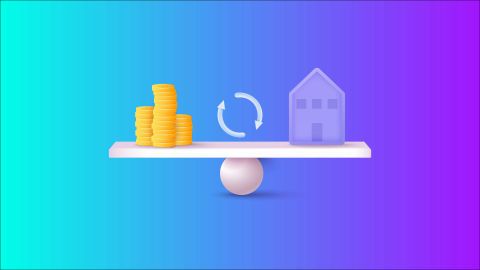Earning a salary of Rs. 15 lakh or more puts you in a higher tax bracket, which means your tax liability can be significant. If you’ve been wondering how much tax applies to such an income, note that any earnings above Rs. 15 lakh attract a 30% tax rate under the new tax regime.
Fortunately, the Income Tax Act allows various deductions and exemptions that can help lower your total tax outgo. With proper planning, you can reduce your taxable income considerably. In this blog, we’ll explore both tax regimes, outline slab rates, and discuss practical ways to reduce your tax burden.
New tax regime slabs per Union Budget 2025
As per the current income tax structure in India, individuals fall under different tax slabs based on their annual income. For the financial year 2025-26, the slabs for individuals below 60 years are as follows:
Income tax slabs |
Income tax rates |
Up to Rs. 4 lakh |
NIL |
Rs. 4 lakh - Rs. 8 lakh |
5% |
Rs. 8 lakh - Rs. 12 lakh |
10% |
Rs.12 lakh - Rs. 16 lakh |
15% |
Rs. 16 lakh - Rs. 20 lakh |
20% |
Rs. 20 lakh - Rs. 24 lakh |
25% |
Above Rs. 24 lakh |
30% |
For a salary of Rs. 15 lakh, an individual would fall into the 15% tax slab. Let us explore strategies to optimise tax planning within this bracket.
Slab rates applicable for FY 2024-2025 (AY 2025-26)
Per the Finance Act 2024, the slab rates for the new tax regime (the default regime) for FY 2024-25 are listed below. These apply to individuals below 60 years of age:
Income range |
Tax rate |
Maximum tax payable |
Up to Rs. 3,00,000 |
Nil |
Rs. 0 |
Rs. 3,00,001 – Rs. 7,00,000 |
5% |
Rs. 20,000 |
Rs. 7,00,001 – Rs. 10,00,000 |
10% |
Rs. 50,000 |
Rs. 10,00,001 – Rs. 12,00,000 |
15% |
Rs. 80,000 |
Rs. 12,00,001 – Rs. 15,00,000 |
20% |
Rs. 1.4 lakh |
Above Rs. 15,00,000 |
30% |
Varies by income |
Standard deduction under this regime is now Rs. 75,000 and family pension deduction is increased to Rs. 25,000.
Strategies for tax planning on a Rs. 15 lakh salary
1. Deductions under Section 80C
Under the old tax regime, you can claim a deduction of up to Rs. 1.5 lakh under Section 80C. You can invest in a variety of financial instruments such as:
Employees’ Provident Fund (EPF)
Public Provident Fund (PPF)
National Savings Certificate (NSC)
Equity Linked Saving Scheme (ELSS)
Life Insurance Premiums
5-Year Fixed Deposits
Sukanya Samriddhi Yojana (SSY)
Repayment of home loan principal
Tuition fees for children
These options not only save tax but also help in long-term financial planning.
2. Home loan tax benefits
A home loan offers tax benefits on both principal repayment and interest paid:
Principal repayment: Up to Rs. 1.5 lakh under Section 80C.
Interest payment: Up to Rs. 2 lakh deduction under Section 24(b).
Additional benefits: First-time homebuyers can claim further deductions under Section 80EE or 80EEA if eligible.
Note: These are applicable only under the old regime.
If you are planning to buy your dream home, a home loan from Bajaj Finserv can help you save significantly on taxes while making homeownership affordable. With interest rates starting from just 7.45%* p.a and loan amounts up to Rs. 15 Crore*, you can reduce your tax burden whilst building wealth through property ownership. Check your eligibility for a home loan from Bajaj Finserv today. You may already be eligible, find out by entering your mobile number and OTP.
3. National Pension Scheme (NPS)
Investing in the NPS can offer extra tax relief:
An additional deduction of Rs. 50,000 under Section 80CCD(1B) on top of Section 80C (old regime).
Employer’s Contribution under Section 80CCD(2) is allowed in both regimes:
Government employees: Up to 14% of basic + DA
Other employees: Up to 10% (old regime) or 14% (new regime)
4. Medical insurance premium (Section 80D)
Health insurance premiums are deductible under Section 80D (old regime):
Category |
Deduction limit |
Self, spouse & children |
Up to Rs. 25,000 |
Senior citizen parents |
Up to Rs. 50,000 |
Preventive health check-up |
Within Rs. 5,000 (part of above limits) |
These benefits not only provide tax relief but also safeguard against medical expenses.
5. Standard Deduction and Professional Tax
Standard deduction:
Rs. 50,000 under old regime
Rs. 75,000 under new regime (from FY 2024–25 onwards)
Professional tax:
Deductible from salary income in states where applicable (usually Rs. 2,400 per year).
Allowed only under the old regime.
6. House rent and travel allowances
Under the old tax regime, salaried employees can claim:
House Rent Allowance (HRA): Exemption based on rent paid, city of residence, and basic salary.
Leave Travel Allowance (LTA): Exemption on domestic travel expenses (actual fares) for two journeys in a block of four years.
You’ll need to provide relevant proofs and bills for claiming these exemptions.
7. Exempt allowances
Certain allowances paid by your employer are tax-free within limits under the old tax regime. Examples include:
Allowance type |
Exemption criteria |
Conveyance & telephone |
If used for official duties with bills |
Children's education |
Rs. 100/month per child (max 2) |
Hostel allowance |
Rs. 300/month per child (max 2) |
Food coupons |
Up to Rs. 50/meal, twice daily |
These can be structured as part of your salary to optimise tax savings.
8. Tax-saving fixed deposits
You can invest in 5-year fixed deposits with banks to claim a deduction under Section 80C (old regime). These FDs are eligible for up to Rs. 1.5 lakh deduction, but note that the interest earned is taxable.
9. Investment diversification
Diversifying your tax-saving investments across different instruments can help reduce risk and maximise returns. Here’s a sample mix under Section 80C:
Instrument |
Suggested amount |
Lock-in |
ELSS Mutual Funds |
Rs. 60,000 |
3 years |
Term Insurance Premium |
Rs. 12,000 |
1 year |
EPF |
Rs. 30,000–Rs. 72,000 |
Till retirement |
Children's Tuition Fees |
Rs. 25,000–Rs. 1 lakh |
Annual |
SSY or NSC |
Rs. 20,000–Rs. 30,000 |
Varies |
You don’t need to invest in all, but aim to make full use of the Rs. 1.5 lakh limit.
10. Gifts and inheritances
Some forms of income are completely exempt from tax:
Gifts received from specified relatives (parents, siblings, spouse, etc.) are tax-free, regardless of the amount.
Gifts from non-relatives are tax-free only up to Rs. 50,000 in a financial year.
Inheritances (e.g. property or money left by a deceased family member) are not taxable. However, income earned from inherited assets is taxable.
Planning around such income sources can help manage your overall tax liability.
Smart tax planning often includes strategic property investments that offer both growth potential and substantial tax benefits. If purchasing a home is part of your financial strategy, Bajaj Finserv provides competitive rates starting at 7.45%* p.a with flexible repayment options up to 32 years. Check your loan offers with Bajaj Finserv to explore how homeownership can enhance your tax-saving portfolio. You may already be eligible, find out by entering your mobile number and OTP.
Tax slabs under old vs. new regime
Choosing the right tax regime is essential, especially if your income is Rs. 15 lakh or more. The old regime offers a range of deductions and exemptions which can significantly reduce your taxable income. In contrast, the new regime comes with lower slab rates but minimal deductions.
Here's a side-by-side comparison of both regimes for FY 2024-25:
Income range |
Tax rate (old regime) |
Income range |
Tax rate (new regime) |
Up to Rs. 2,50,000 |
Nil |
Up to Rs. 3,00,000 |
Nil |
Rs. 2,50,001 – Rs. 5,00,000 |
5% |
Rs. 3,00,001 – Rs. 7,00,000 |
5% |
Rs. 5,00,001 – Rs. 10,00,000 |
20% |
Rs. 7,00,001 – Rs. 10,00,000 |
10% |
Above Rs. 10,00,000 |
30% |
Rs. 10,00,001 – Rs. 12,00,000 |
15% |
|
|
Rs. 12,00,001 – Rs. 15,00,000 |
20% |
|
|
Above Rs. 15,00,000 |
30% |
Note: Old regime exemptions differ based on age. Individuals aged 60–80 have a basic exemption of Rs. 3 lakh and above 80 years, Rs. 5 lakh.
Deductions and exemptions under new tax regime
India's new tax regime, introduced in the Union Budget 2020, offers lower tax rates but eliminates some deductions and exemptions. This article explores key features, deductions, and exemptions under the new tax structure and provides insights for optimising financial planning.
Key features of the new tax regime
Some of its highlights include:
Flat tax slabs for all individuals, including senior and super senior citizens.
A rebate of up to Rs. 25,000 under Section 87A for incomes up to Rs. 7 lakh.
Standard deduction raised to Rs. 75,000 for salaried individuals.
Deduction on family pension increased to Rs. 25,000.
Employer’s contribution to NPS is deductible up to 14% of salary + DA.
Maximum surcharge has been reduced to 25%.
Despite fewer deductions, the lower tax rates and simpler compliance process make this a suitable option for many taxpayers.
Deductions and exemptions under the new tax regime
A standard deduction of up to Rs. 75,000 is available for salaried individuals.
Contributions made by your employer to the National Pension Scheme (NPS) under Section 80CCD(2) qualify for a deduction.
Investments made into the Agniveer Corpus Fund under Section 80CCH are also eligible.
Pension received by family members can be deducted under Section 57(iia).
You can claim tax relief on gratuity, leave encashment, and voluntary retirement payouts under sections 10(10), 10(10AA), and 10(10C).
Interest paid on home loans for rented properties can be deducted under Section 24.
Special tax allowances are given for transport if the person is specially-abled.
Conveyance allowances and travel reimbursements related to your job are also tax-free.
Optimising financial planning under the new tax regime
- Evaluate deduction impact: Assess the impact of foregone deductions on overall tax liability.
- Consider individual circumstances: Evaluate personal circumstances to determine the most beneficial tax regime.
- Tax planning through investments: Explore alternative tax-saving investments such as NPS and Atal Pension Yojana.
- Consult with financial advisers: Seek advice from professionals to understand the implications and make informed decisions.
Deductions and exemptions under old tax regime
If your annual income is Rs. 15 lakh and you opt for the old tax regime, you can take advantage of multiple tax-saving options through exemptions and deductions.
1. Salary-based exemptions
Your salary may include several tax-free components, depending on your company’s structure:
Salary component |
Tax treatment |
Basic Salary and Dearness Allowance |
Fully taxable |
House Rent Allowance (HRA) |
Partially exempt, depending on rent paid and city of residence |
Leave Travel Allowance (LTA) |
Exempt for 2 domestic trips in 4 years if travel bills are submitted |
Mobile/Internet Reimbursement |
Exempt if used mainly for work and bills are submitted |
Children’s Education and Hostel Allowance |
Up to Rs. 4,800 per child for education (max 2 children) |
Food Coupons or Vouchers |
Up to Rs. 50 per meal for 2 meals per working day (Rs. 26,400 annually) |
Professional Tax |
Up to Rs. 2,400, varies by state |
2. Deductions you can claim
You can also reduce your tax by claiming deductions on the following:
Particulars |
Maximum deduction allowed |
Health Insurance Premium (Section 80D) |
Rs. 25,000 for self + family, Rs. 50,000 for senior citizen parents |
Education Loan Interest (Section 80E) |
Full interest deduction for 8 years |
Donations to Charity (Section 80G) |
50% or 100% of the donated amount |
Tax-Saving Investments (Section 80C) |
Up to Rs. 1.5 lakh (EPF, PPF, ELSS, NSC, SSY, 5-yr FD, etc.) |
Expenses for Disabled Dependants (80DD) |
Rs. 75,000 for 40% disability; Rs. 1,25,000 for severe disability |
Home Loan Principal & Interest |
Rs. 1.5 lakh (principal - 80C), Rs. 2 lakh (interest - 24b) |
Life Insurance Maturity Proceeds |
Tax-free if premiums meet required ratio to sum assured |
Standard Deduction |
Rs. 50,000 flat deduction for salaried individuals |
To make full use of the Rs. 1.5 lakh limit under Section 80C, consider investing in ELSS (Rs. 60,000), term insurance (Rs. 12,000), ULIPs or endowment plans (Rs. 12,000), paying school fees (Rs. 25,000 to Rs. 1 lakh), and contributing to EPF (Rs. 30,000 to Rs. 72,000).
Property investment through home loans remains one of the most effective ways to maximise your Section 80C benefits whilst building long-term wealth. With Bajaj Finserv, you can claim deductions on both principal repayment and interest payments, potentially saving lakhs in taxes annually. Check your eligibility for competitive home loan rates starting from 7.45%* p.a. You may already be eligible, find out by entering your mobile number and OTP.
The new tax regime offers lower rates but eliminates certain deductions. Taxpayers should carefully assess their financial goals, consider alternative tax-saving avenues, and seek professional advice for informed decision-making.
How to save taxes for an income of Rs. 15 lakh?
If you earn Rs. 15 lakh annually, you can still lower your tax liability by making the most of available deductions and exemptions under both the old and new tax regimes. While the new tax regime offers fewer deductions, it provides a lower tax rate. The old regime allows a wide range of tax-saving options through exemptions and deductions under various sections.
1. Employer’s contribution to NPS – Section 80CCD(2)
Whether you follow the old or new regime, your employer’s contribution to the National Pension Scheme (NPS) qualifies for tax relief. However, the limit of this deduction depends on the type of employer and tax regime.
Employer type |
Old regime deduction |
New regime deduction |
Central or State Government |
14% of Basic + DA |
14% of Basic + DA |
Private Sector/Other Employers |
10% of Basic + DA |
14% of Basic + DA |
2. Gift taxation – Section 56
Any gift received, whether in cash or kind, is tax-free up to Rs. 50,000 in a financial year. However, if the total value exceeds this amount, the entire sum becomes taxable. This applies under both tax regimes.
3. Interest on loan for let-out property – Section 24
If you own a property that is rented out, you can claim the interest paid on the loan taken to purchase or build the property. There is no cap on this deduction, and it is available under both the new and old tax regimes.
4. Gratuity and leave encashment
When you retire or leave a job, payments received as gratuity or encashed leave are exempt up to a limit under Section 10. These exemptions apply under both tax systems, subject to specific thresholds set by law.
5. Additional employee cost – Section 80JJAA
If you run a business and hire more employees, you can claim a deduction of 30% on the additional employee cost for three years. This benefit applies whether you follow the new or old regime.
6. Agniveer Corpus Fund – Section 80CCH(2)
Those enrolled under the Agnipath scheme in the armed forces can claim a full deduction on the contribution made by the Central Government to the Agniveer Corpus Fund. There is no limit on this deduction, and it is available under both tax regimes.
Calculating Tax Under Old and New Tax Regimes
If you earn a salary of Rs. 15 lakh annually, it's important to understand how your taxes may vary depending on whether you choose the old tax regime or the new one. To illustrate this better, let’s take the case of Ms Maya, who has a yearly salary of Rs. 15 lakh. She receives various allowances and also invests in tax-saving instruments.
Under the old tax regime, she is eligible to claim several exemptions and deductions, including:
HRA exemption: Rs. 1,00,000
Leave Travel Allowance (LTA): Rs. 20,000
Children’s education and hostel allowance: Rs. 9,600
Standard deduction: Rs. 50,000
Professional tax: Rs. 2,400
Section 80C investment (e.g., PPF): Rs. 1,50,000
Voluntary NPS contribution under Section 80CCD(1B): Rs. 50,000
Medical insurance premium under Section 80D: Rs. 25,000
On the other hand, under the new tax regime, she cannot claim these exemptions, but the tax slabs offer reduced rates. Let’s compare both regimes for FY 2025-26 using a simplified table:
Details |
Old tax regime |
New tax regime |
Gross Salary |
Rs. 15,00,000 |
Rs. 15,00,000 |
Exemptions (HRA, LTA, etc.) |
Rs. 1,29,600 |
Not Applicable |
Standard Deduction |
Rs. 50,000 |
Rs. 75,000 |
Professional Tax |
Rs. 2,400 |
Not Applicable |
Chapter VI-A Deductions (80C, 80CCD, 80D) |
Rs. 2,25,000 |
Not Applicable |
Net taxable income |
Rs. 10,93,000 |
Rs. 14,25,000 |
Total tax payable (including cess) |
Rs. 1,46,016 |
Rs. 97,500 |
A breakdown of how the tax is calculated under each regime is given below:
Tax Breakdown: FY 2025–26
Old regime
Up to Rs. 2.5 lakh: Nil
Rs. 2.5 – 5 lakh: Rs. 12,500
Rs. 5 – 10 lakh: Rs. 1,00,000
Rs. 10 – 10.93 lakh: Rs. 27,900
Cess (4%): Rs. 5,616
Total: Rs. 1,46,016
New regime
Rs. 4 – 8 lakh at 5%: Rs. 20,000
Rs. 8 – 12 lakh at 10%: Rs. 40,000
Rs. 12 – 14.25 lakh at 15%: Rs. 33,750
Cess (4%): Rs. 3,750
Total: Rs. 97,500
For FY 2024–25
Details |
Old regime |
New regime |
Net Taxable Income |
Rs. 10,93,000 |
Rs. 14,25,000 |
Tax Payable (incl. cess) |
Rs. 1,46,016 |
Rs. 1,30,000 |
As seen, in FY 2025–26, the new tax regime results in lower tax payable by Rs. 48,516. However, in FY 2024–25, the old regime offered more tax savings. This highlights the importance of choosing your tax regime based on your eligible deductions and annual investments.
Whether you choose the old or new tax regime, strategic financial decisions like home ownership can significantly impact your tax liability and wealth creation. A home loan from Bajaj Finserv not only helps you secure your dream property but also provides substantial tax benefits under both regimes. Check your home loan eligibility with Bajaj Finserv to explore rates starting from 7.45%* p.a You may already be eligible, find out by entering your mobile number and OTP.
Popular calculators for your financial calculations
Other topics you might find interesting |
|||
|
|||




